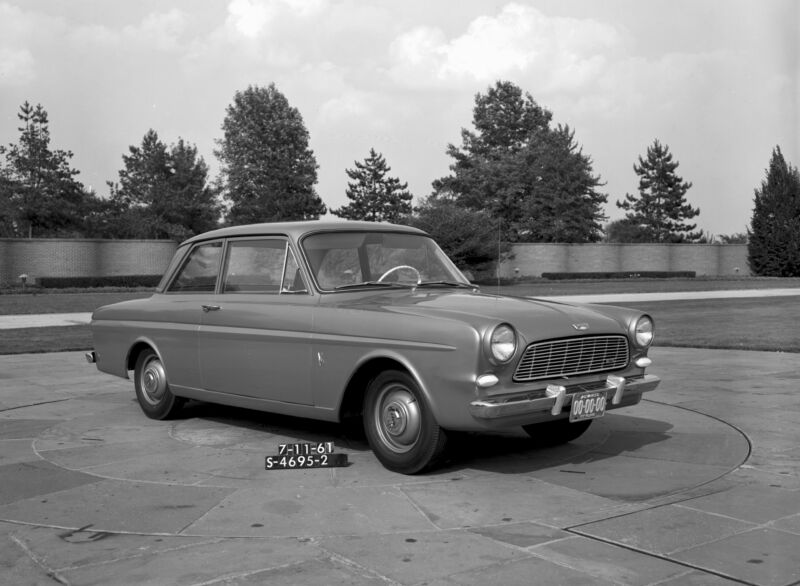Beetle Envy —
Here’s what happened when Ford tried to react to the Volkswagen Beetle.

Enlarge / This was supposed to be Ford’s answer to the VW Beetle, a small, light, efficient, front-wheel drive car called Cardinal.
Ford
Between 100 percent tariffs and now an impending ban on software, it’s clear that America’s auto industry is more than a little worried about having its lunch eaten by heavily subsidized Chinese car makers. But it’s far from the first time that the suits in Detroit have seen storm clouds arriving from far-off lands.
In 1957, Detroit automakers’ dominance of the US market seemed unbeatable. Smaller, independent American automakers Studebaker, Packard, Nash, Hudson, Kaiser, and Willys-Overland underwent various mergers to match the might of General Motors, Ford, and Chrysler to little avail.
Yet America’s Big Three faced a small but growing problem: foreign automakers.
The fastest-growing? Volkswagen. Inordinately popular worldwide, the automaker sold its millionth car in 1957, of which 36,000 were sold in the United States, making it the automaker’s largest export market. Ironically, the problem was of Detroit’s making. The Big Three had been offered the bombed-out remnants of Volkswagen for free seven years earlier. Their attitude was summarized by Ernie Breech, Ford’s newly appointed chairman of the board, who told Henry Ford II in 1948, “I don’t think what we’re being offered here is worth a dime.”
The automaker Ford spurned was among a flood of increasingly popular imported small cars. While Ford held 31 percent of the US market, it had nothing to counter the Volkswagen Beetle or other Lilliputian imports like the Renault Dauphine. An internal Ford report cited the surprising trend.
Surprising? Yes.
Independent American automakers had tried selling smaller cars. And while the 1950 Nash Rambler and 1953 Nash Metropolitan proved popular, other attempts, like the 1951 Kaiser Henry J and the 1953 Hudson Jet, flopped disastrously. So, it seemed that Americans didn’t like small cars.
More accurately, they didn’t like the small cars American automakers offered. They did like the ones being imported from Europe. New foreign car registrations in the US ballooned from 12,000 units in 1949 to 207,000 by 1957 and were projected to reach 625,000 by 1961 before falling to 495,000 in 1963. By 1959, even Studebaker noticed and launched the compact Lark. Its sales proved popular enough to reverse its slow slide to oblivion momentarily.
-
While Europeans were driving small cars, Americans preferred something that could seat six, like this 1960 Ford Falcon.
Ford
-
Back then, sedans came with two or four doors.
Ford
-
Robert McNamara was president of Ford until he was appointed secretary of defense by US President John F Kennedy. The Cardinal was his brainchild.
Ford
-
Lee Iacocca took over from McNamara, and had little time for his predecessor’s plans.
Ford
The Big Three responded with new compacts in 1960 with the Chevrolet Corvair, Chrysler Valiant, and Ford Falcon, as well as the upscale Pontiac Tempest, Oldsmobile F-85, Buick Skylark, Dodge Dart, and Mercury Comet—the latter planned as an Edsel until the marque folded in 1959. Of the compacts, the Falcon proved to be the most popular despite being plainly styled, spartan in trim, and unabashedly utilitarian. It was the vision of Ford Motor Company President Robert McNamara.
“McNamara believed in basic transportation without gimmicks, and with the Falcon, he put his ideas into practice,” said Lee Iacocca, then a rising star at Ford. “I had to admire its success. Here was a car priced to compete with the small imports, which were starting to come on strong and had already reached nearly 10 percent of the American market. But unlike the imports, the Falcon carried six passengers, which made it large enough for most American families.”
The Ford Falcon sold 417,174 units in its first year, a record broken by the 1965 Ford Mustang’s 418,812 units and later by the 1978 Ford Fairmont’s 422,690 units.
It was a remarkable feat for a company fresh off the humbling failure of the mid-market Edsel. Promoted as something revolutionary, the Edsel was anything but. In contrast, the growing consumer acceptance of smaller cars proved that consumers demanded something fresh. And Ford President Robert McNamara believed he had the answer.